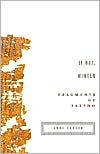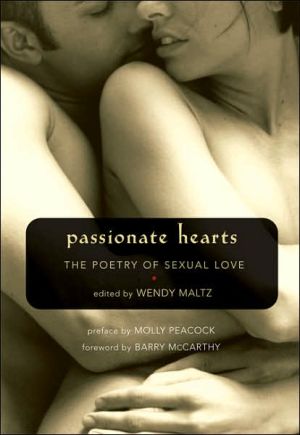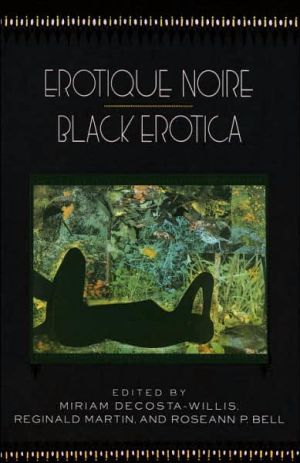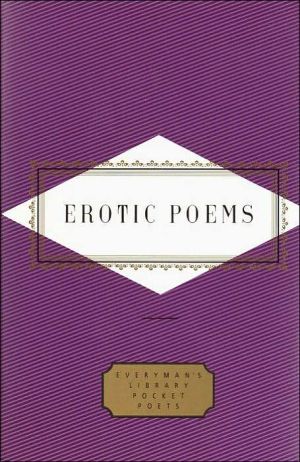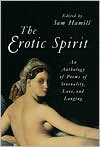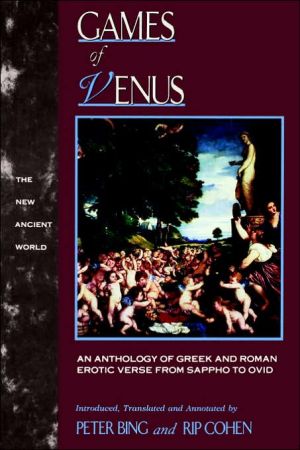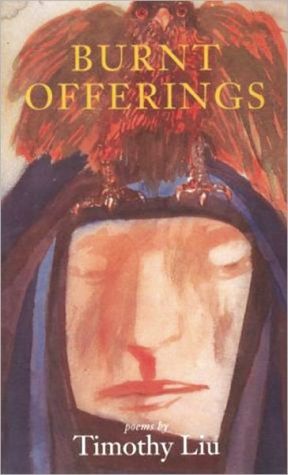If Not, Winter: Fragments of Sappho
Of the nine books of lyrics the ancient Greek poet Sappho is said to have composed, only one poem has survived complete. The rest are fragments. In this miraculous new translation, acclaimed poet and classicist Anne Carson presents all of Sappho’s fragments, in Greek and in English, as if on the ragged scraps of papyrus that preserve them, inviting a thrill of discovery and conjecture that can be described only as electric—or, to use Sappho’s words, as “thin fire . . . racing under skin.” By...
Search in google:
Of the nine books of lyrics the ancient Greek poet Sappho is said to have composed, only one poem has survived complete. The rest are fragments. In this miraculous new translation, acclaimed poet and classicist Anne Carson presents all of Sappho’s fragments, in Greek and in English, as if on the ragged scraps of papyrus that preserve them, inviting a thrill of discovery and conjecture that can be described only as electric—or, to use Sappho’s words, as “thin fire . . . racing under skin.” By combining the ancient mysteries of Sappho with the contemporary wizardry of one of our most fearless and original poets, If Not, Winter provides a tantalizing window onto the genius of a woman whose lyric power spans millennia.Publishers WeeklyA classicist at McGill University, Carson has mined Greek literature, and Sappho in particular, to tremendous effect and acclaim in her poetry and essays. Her prose Eros the Bittersweet (1986) discussed Sappho's term "glukupikron" ("sweetbitter") among other Greek concepts, while the poems of Autobiography of Red (1998) reinvented surviving fragments of the Greek poet Stesichoros, to take just two examples. Here, Carson fully channels one of the most iconic yet least transparent Greek poets, whose work comes to us mostly in fragments. In a four-page preface, Carson addresses the fact that very little is known for certain about Sappho, apart from the fact that she lived in the "city of Mytilene on the island of Lesbos from about 630 B.C." and "appears to have devoted her life to composing songs." She bases her translation, beautifully presented here with the Greek en face, on a 1971 transcription by the scholar Eva-Maria Voigt, published in Amsterdam, and includes all the fragments published by Voigt in which "at least one word is legible," using "the plainest language I could find, using where possible the same order of words and thoughts as Sappho did." Since Sappho's texts are fragments, it is inevitable that Carson offers some pages that are mostly brackets indicating missing material, suggestively interspersed with the words "youth" or "sinful," for example, or the phrases "as long as you want" or "my darling one." As with Joyce's Homeric "winedark sea," Carson includes compounds like "sweetflowing" or "farshooting" to render complex Greek words. Carson grudgingly allows a lesbian interpretation for some of the poems, noting that "[i]t seems that she knew and loved women as deeply as she did music. Can we leave the matter there?" (About an equal number of poems in this collection are about loving men.) With 26 cogent pages of notes to individual poems, an eight-page "Who's Who" of names mentioned in the poems, four pages of "Testimonia" about Sappho and Carson's get-out-of-the-way-of-the-poems approach to translation, the uninitiated should have no problem entering this rich territory and constructing their own versions of the enigmatic poet. (Aug. 29) Forecast: The combination of one of the most acclaimed poets of the last 10 years and one of the most haunting of the last 2,000 should be electric at the register. Carson has won a MacArthur Fellowship and has been profiled extensively in the press. Expect interest in this title to be extremely high across the board; at present, it is a selection of The Reader's Subscription, Insightout and Quality Paperback Book Club. Aside from perhaps the various Heartsongs editions, this should be the poetry bestseller of the year and a very strong seller for years to come. Copyright 2002 Cahners Business Information.
Fragment 22\ ]\ ]work\ ]face\ ]\ ]\ if not, winter\ ]no pain\ ]\ ]I bid you sing of Gongyla, Abanthis, taking up your lyre as (now again) longing floats around you.\ you beauty. For her dress when you saw it stirred you. And I rejoice.\ In fact she herself once blamed me Kyprogeneia\ because I prayed this word:\ I want\ \ Fragment 47\ Eros shook my mind like a mountain wind falling on oak trees\ Fragment 52\ I would not think to touch the sky with two arms\ \ Fragment 56\ not one girl I think who looks on the light of the sun will ever have wisdom like this\ Fragment 147\ someone will remember us I say even in another time\ Fragment 162\ with what eyes?
\ Publishers WeeklyA classicist at McGill University, Carson has mined Greek literature, and Sappho in particular, to tremendous effect and acclaim in her poetry and essays. Her prose Eros the Bittersweet (1986) discussed Sappho's term "glukupikron" ("sweetbitter") among other Greek concepts, while the poems of Autobiography of Red (1998) reinvented surviving fragments of the Greek poet Stesichoros, to take just two examples. Here, Carson fully channels one of the most iconic yet least transparent Greek poets, whose work comes to us mostly in fragments. In a four-page preface, Carson addresses the fact that very little is known for certain about Sappho, apart from the fact that she lived in the "city of Mytilene on the island of Lesbos from about 630 B.C." and "appears to have devoted her life to composing songs." She bases her translation, beautifully presented here with the Greek en face, on a 1971 transcription by the scholar Eva-Maria Voigt, published in Amsterdam, and includes all the fragments published by Voigt in which "at least one word is legible," using "the plainest language I could find, using where possible the same order of words and thoughts as Sappho did." Since Sappho's texts are fragments, it is inevitable that Carson offers some pages that are mostly brackets indicating missing material, suggestively interspersed with the words "youth" or "sinful," for example, or the phrases "as long as you want" or "my darling one." As with Joyce's Homeric "winedark sea," Carson includes compounds like "sweetflowing" or "farshooting" to render complex Greek words. Carson grudgingly allows a lesbian interpretation for some of the poems, noting that "[i]t seems that she knew and loved women as deeply as she did music. Can we leave the matter there?" (About an equal number of poems in this collection are about loving men.) With 26 cogent pages of notes to individual poems, an eight-page "Who's Who" of names mentioned in the poems, four pages of "Testimonia" about Sappho and Carson's get-out-of-the-way-of-the-poems approach to translation, the uninitiated should have no problem entering this rich territory and constructing their own versions of the enigmatic poet. (Aug. 29) Forecast: The combination of one of the most acclaimed poets of the last 10 years and one of the most haunting of the last 2,000 should be electric at the register. Carson has won a MacArthur Fellowship and has been profiled extensively in the press. Expect interest in this title to be extremely high across the board; at present, it is a selection of The Reader's Subscription, Insightout and Quality Paperback Book Club. Aside from perhaps the various Heartsongs editions, this should be the poetry bestseller of the year and a very strong seller for years to come. Copyright 2002 Cahners Business Information.\ \ \ \ \ Library JournalThe lyric poetry of antiquity is often as important to modern poets as it is to translators and classical scholars. Mulroy is a professor of classics (Univ. of Wisconsin, Milwaukee), and Carson (classics, McGill Univ.; The Beauty of the Husband) and the late William Matthews (After All: Last Poems) are well-regarded poets. Following Pound's dictum to "make it new," Mulroy and Matthews translate Catullus and Horace into modern American idiom, striving where possible to find cultural equivalents rather than literal translations. At the same time, they try to be true to the shifting tones and rhythms of their originals. The results are fluent, giving some sense of the contemporaneousness that Catullus and Horace would have evoked in their audiences. Carson's translation follows Sappho's diction and form much more closely and includes the Greek original on the facing page. Much of what survives of Sappho are fragments, often just a stray word, phrase, or even a few letters. Like many modern poets, Carson deploys these on the blank page, letting their suggestiveness fill the gaps and create whole lyrics in the imagination of the readers. All three translators aim for a general audience, though Mulroy and Carson also include notes and introductions of value to the more scholarly reader. All three books are recommended for both public and academic libraries. T.L. Cooksey, Armstrong Atlantic State Univ., Savannah, GA Copyright 2002 Cahners Business Information.\ \
